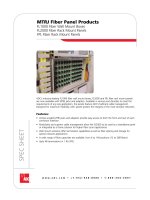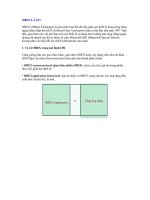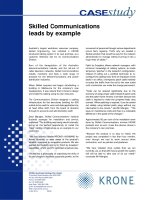Tài liệu Programming Embedded Systems II pptx
Bạn đang xem bản rút gọn của tài liệu. Xem và tải ngay bản đầy đủ của tài liệu tại đây (2.06 MB, 273 trang )
I
Programming
Embedded
Systems II
A 10-week course, using C
40
39
38
37
36
35
34
1
2
3
4
5
6
7
‘8051’
8
9
10
33
32
31
30
29
28
27
26
25
24
11
12
13
14
15
16
17
18
19
20
23
22
21
P3.0
P1.7
RST
P1.6
P1.5
P1.4
P1.2
P1.3
P1.1
P1.0
VSS
XTL2
XTL1
P3.7
P3.6
P3.5
P3.3
P3.4
P3.2
P3.1
/ EA
P0.6
P0.7
P0.5
P0.4
P0.3
P0.1
P0.2
P0.0
VCC
P2.0
P2.2
P2.1
P2.3
P2.4
P2.5
P2.7
P2.6
/ PSEN
ALE
Michael J. Pont
University of Leicester
[v2.0]
II
Copyright © Michael J. Pont, 2002-2004
This document may be freely distributed and copied, provided that copyright notice at
the foot of each OHP page is clearly visible in all copies.
III
Seminar 1: 1
Seminar 2: A flexible scheduler for single-processor embedded systems 1
Overview of this seminar 2
Overview of this course 3
By the end of the course you’ll be able to … 4
Main course text 5
IMPORTANT: Course prerequisites 6
Review: Why use C? 7
Review: The 8051 microcontroller 8
Review: The “super loop” software architecture 9
Review: An introduction to schedulers 10
Review: Building a scheduler 11
Overview of this seminar 12
The Co-operative Scheduler 13
Overview 14
The scheduler data structure and task array 15
The size of the task array 16
One possible initialisation function: 17
IMPORTANT: The ‘one interrupt per microcontroller’ rule! 18
The ‘Update’ function 19
The ‘Add Task’ function 20
The ‘Dispatcher’ 22
Function arguments 24
Function pointers and Keil linker options 25
The ‘Start’ function 28
The ‘Delete Task’ function 29
Reducing power consumption 30
Reporting errors 31
Displaying error codes 34
Hardware resource implications 35
What is the CPU load of the scheduler? 36
Determining the required tick interval 38
Guidelines for predictable and reliable scheduling 40
Overall strengths and weaknesses of the scheduler 41
Preparations for the next seminar 42
IV
Seminar 3: Analogue I/O using ADCs and PWM 43
Overview of this seminar 44
PATTERN: One-Shot ADC 45
PATTERN: One-Shot ADC 46
Using a microcontroller with on-chip ADC 47
Using an external parallel ADC 48
Example: Using a Max150 ADC 49
Using an external serial ADC 51
Example: Using an external SPI ADC 52
Overview of SPI 53
Back to the example … 54
Example: Using an external I
2
C ADC 55
Overview of I2C 56
Back to the example … 57
What is PWM? 58
PATTERN: Software PWM 59
Preparations for the next seminar 62
V
Seminar 4: A closer look at co-operative task scheduling (and some alternatives) 63
Overview of this seminar 64
Review: Co-operative scheduling 65
The pre-emptive scheduler 66
Why do we avoid pre-emptive schedulers in this course? 67
Why is a co-operative scheduler (generally) more reliable? 68
Critical sections of code 69
How do we deal with critical sections in a pre-emptive system? 70
Building a “lock” mechanism 71
The “best of both worlds” - a hybrid scheduler 75
Creating a hybrid scheduler 76
The ‘Update’ function for a hybrid scheduler. 78
Reliability and safety issues 81
The safest way to use the hybrid scheduler 83
Other forms of co-operative scheduler 85
PATTERN: 255-T
ICK
S
CHEDULER
86
PATTERN: O
NE
-T
ASK
S
CHEDULER
87
PATTERN: O
NE
-Y
EAR
S
CHEDULER
88
PATTERN: S
TABLE
S
CHEDULER
89
Mix and match … 90
Preparations for the next seminar 91
VI
Seminar 5: Improving system reliability using watchdog timers 93
Overview of this seminar 94
The watchdog analogy 95
PATTERN: Watchdog Recovery 96
Choice of hardware 97
Time-based error detection 98
Other uses for watchdog-induced resets 99
Recovery behaviour 100
Risk assessment 101
The limitations of single-processor designs 102
Time, time, time … 103
Watchdogs: Overall strengths and weaknesses 104
PATTERN: Scheduler Watchdog 105
Selecting the overflow period - “hard” constraints 106
Selecting the overflow period - “soft” constraints 107
PATTERN: Program-Flow Watchdog 108
Dealing with errors 110
Hardware resource implications 111
Speeding up the response 112
PATTERN: Reset Recovery 114
PATTERN: Fail-Silent Recovery 115
Example: Fail-Silent behaviour in the Airbus A310 116
Example: Fail-Silent behaviour in a steer-by-wire application 117
PATTERN: Limp-Home Recovery 118
Example: Limp-home behaviour in a steer-by-wire application 119
PATTERN: Oscillator Watchdog 122
Preparations for the next seminar 124
VII
Seminar 6: Shared-clock schedulers for multi-processor systems 125
Overview of this seminar 126
Why use more than one processor? 127
Additional CPU performance and hardware facilities 128
The benefits of modular design 130
The benefits of modular design 131
So - how do we link more than one processor? 132
Synchronising the clocks 133
Synchronising the clocks 134
Synchronising the clocks - Slave nodes 135
Transferring data 136
Transferring data (Master to Slave) 137
Transferring data (Slave to Master) 138
Transferring data (Slave to Master) 139
Detecting network and node errors 140
Detecting errors in the Slave(s) 141
Detecting errors in the Master 142
Handling errors detected by the Slave 143
Handling errors detected by the Master 144
Enter a safe state and shut down the network 145
Reset the network 146
Engage a backup Slave 147
Why additional processors may not improve reliability 148
Redundant networks do not guarantee increased reliability 149
Replacing the human operator - implications 150
Are multi-processor designs ever safe? 151
Preparations for the next seminar 152
VIII
Seminar 7: Linking processors using RS-232 and RS-485 protocols 153
Review: Shared-clock scheduling 154
Overview of this seminar 155
Review: What is ‘RS-232’? 156
Review: Basic RS-232 Protocol 157
Review: Transferring data to a PC using RS-232 158
PATTERN: SCU S
CHEDULER
(L
OCAL
) 159
The message structure 160
Determining the required baud rate 163
Node Hardware 165
Network wiring 166
Overall strengths and weaknesses 167
PATTERN: SCU Scheduler (RS-232) 168
PATTERN: SCU Scheduler (RS-485) 169
RS-232 vs RS-485 [number of nodes] 170
RS-232 vs RS-485 [range and baud rates] 171
RS-232 vs RS-485 [cabling] 172
RS-232 vs RS-485 [transceivers] 173
Software considerations: enable inputs 174
Overall strengths and weaknesses 175
Example: Network with Max489 transceivers 176
Preparations for the next seminar 177
IX
Seminar 8: Linking processors using the Controller Area Network (CAN) bus 179
Overview of this seminar 180
PATTERN: SCC Scheduler 181
What is CAN? 182
CAN 1.0 vs. CAN 2.0 184
Basic CAN vs. Full CAN 185
Which microcontrollers have support for CAN? 186
S-C scheduling over CAN 187
The message structure - Tick messages 188
The message structure - Ack messages 189
Determining the required baud rate 190
Transceivers for distributed networks 192
Node wiring for distributed networks 193
Hardware and wiring for local networks 194
Software for the shared-clock CAN scheduler 195
Overall strengths and weaknesses 196
Example: Creating a CAN-based scheduler using the Infineon C515c 197
Master Software 198
Slave Software 211
What about CAN without on-chip hardware support? 218
Preparations for the next seminar 220
X
Seminar 9: Applying “Proportional Integral Differential” (PID) control 221
Overview of this seminar 222
Why do we need closed-loop control? 223
Closed-loop control 227
What closed-loop algorithm should you use? 228
What is PID control? 229
A complete PID control implementation 230
Another version 231
Dealing with ‘windup’ 232
Choosing the controller parameters 233
What sample rate? 234
Hardware resource implications 235
PID: Overall strengths and weaknesses 236
Why open-loop controllers are still (sometimes) useful 237
Limitations of PID control 238
Example: Tuning the parameters of a cruise-control system 239
Open-loop test 241
Tuning the PID parameters: methodology 242
First test 243
Example: DC Motor Speed Control 245
Alternative: Fuzzy control 248
Preparations for the next seminar 249
XI
Seminar 10: Case study: Automotive cruise control using PID and CAN 251
Overview of this seminar 252
Single-processor system: Overview 253
Single-processor system: Code 254
Multi-processor design: Overview 255
Multi-processor design: Code (PID node) 256
Multi-processor design: Code (Speed node) 257
Multi-processor design: Code (Throttle node) 258
Exploring the impact of network delays 259
Example: Impact of network delays on the CCS system 260
That’s it! 261
XII
C
OPYRIGHT
© M
ICHAEL
J. P
ONT
, 2001-2004. Contains material from:
Pont, M.J. (2001) “Patterns for triggered embedded systems”, Addison-Wesley.
PES II - 1
Seminar 1:
Seminar 2:
A flexible scheduler
for single-processor
embedded systems
40
39
38
37
36
35
34
1
2
3
4
5
6
7
‘8051’
8
9
10
33
32
31
30
29
28
27
26
25
24
11
12
13
14
15
16
17
18
19
20
23
22
21
P3.0
P1.7
RST
P1.6
P1.5
P1.4
P1.2
P1.3
P1.1
P1.0
VSS
XTL2
XTL1
P3.7
P3.6
P3.5
P3.3
P3.4
P3.2
P3.1
/ EA
P0.6
P0.7
P0.5
P0.4
P0.3
P0.1
P0.2
P0.0
VCC
P2.0
P2.2
P2.1
P2.3
P2.4
P2.5
P2.7
P2.6
/ PSEN
ALE
C
OPYRIGHT
© M
ICHAEL
J. P
ONT
, 2001-2004. Contains material from:
Pont, M.J. (2001) “Patterns for triggered embedded systems”, Addison-Wesley.
PES II - 2
Overview of this seminar
This introductory seminar will run over TWO SESSIONS:
It will:
•
Provide an overview of this course (this seminar slot)
•
Describe the design and implementation of a flexible
scheduler (this slot and the next slot)
C
OPYRIGHT
© M
ICHAEL
J. P
ONT
, 2001-2004. Contains material from:
Pont, M.J. (2001) “Patterns for triggered embedded systems”, Addison-Wesley.
PES II - 3
Overview of this course
This course is primarily concerned with the implementation of
software (and a small amount of hardware) for embedded systems
constructed using more than one microcontroller.
The processors examined in detail will be from the 8051 family.
All programming will be in the ‘C’ language
(using the Keil C51 compiler)
C
OPYRIGHT
© M
ICHAEL
J. P
ONT
, 2001-2004. Contains material from:
Pont, M.J. (2001) “Patterns for triggered embedded systems”, Addison-Wesley.
PES II - 4
By the end of the course you’ll be able to …
By the end of the course, you will be able to:
1. Design software for multi-processor embedded applications
based on small, industry standard, microcontrollers;
2. Implement the above designs using a modern, high-level
programming language (‘C’), and
3. Understand more about the effect that software design and
programming designs can have on the reliability and safety
of multi-processor embedded systems.
C
OPYRIGHT
© M
ICHAEL
J. P
ONT
, 2001-2004. Contains material from:
Pont, M.J. (2001) “Patterns for triggered embedded systems”, Addison-Wesley.
PES II - 5
Main course text
Throughout this course, we will be making heavy use of this book:
Patterns for time-triggered embedded
systems: Building reliable applications with
the 8051 family of microcontrollers,
by Michael J. Pont (2001)
Addison-Wesley / ACM Press.
[ISBN: 0-201-331381]
For further details, please see:
/>C
OPYRIGHT
© M
ICHAEL
J. P
ONT
, 2001-2004. Contains material from:
Pont, M.J. (2001) “Patterns for triggered embedded systems”, Addison-Wesley.
PES II - 6
IMPORTANT: Course prerequisites
•
It is assumed that - before taking this course - you have
previously completed “Programming Embedded Systems I”
(or a similar course).
See:
www.le.ac.uk/engineering/mjp9/pttesguide.htm
B
E
C
5.5V, 0.3A lamp
ZTX751
4V - 6V (battery)
10 KΩ
10 µF
4 MHz
20
19
18
17
16
15
14
1
2
3
4
5
6
7
Atmel 2051
8
9
10
13
12
11
GND
P3.4
P3.5
P3.3
P3.2
XTL1
P3.1
XTL2
P3.0
RST
P3.7
P1.1
P1.0
P1.2
P1.3
P1.4
P1.6
P1.5
P1.7
VCC
40
39
38
37
36
35
34
1
2
3
4
5
6
7
‘8051’
8
9
10
33
32
31
30
29
28
27
26
25
24
11
12
13
14
15
16
17
18
19
20
23
22
21
P3.0
P1.7
RST
P1.6
P1.5
P1.4
P1.2
P1.3
P1.1
P1.0
VSS
XTL2
XTL1
P3.7
P3.6
P3.5
P3.3
P3.4
P3.2
P3.1
/ EA
P0.6
P0.7
P0.5
P0.4
P0.3
P0.1
P0.2
P0.0
VCC
P2.0
P2.2
P2.1
P2.3
P2.4
P2.5
P2.7
P2.6
/ PSEN
ALE
C
OPYRIGHT
© M
ICHAEL
J. P
ONT
, 2001-2004. Contains material from:
Pont, M.J. (2001) “Patterns for triggered embedded systems”, Addison-Wesley.
PES II - 7
Review: Why use C?
•
It is a ‘mid-level’ language, with ‘high-level’ features (such
as support for functions and modules), and ‘low-level’
features (such as good access to hardware via pointers);
•
It is very efficient;
•
It is popular and well understood;
•
Even desktop developers who have used only Java or C++
can soon understand C syntax;
•
Good, well-proven compilers are available for every
embedded processor (8-bit to 32-bit or more);
•
Experienced staff are available;
•
Books, training courses, code samples and WWW sites
discussing the use of the language are all widely available.
Overall, C may not be an ideal language for developing embedded
systems, but it is a good choice (and is unlikely that a ‘perfect’ language
will ever be created).
C
OPYRIGHT
© M
ICHAEL
J. P
ONT
, 2001-2004. Contains material from:
Pont, M.J. (2001) “Patterns for triggered embedded systems”, Addison-Wesley.
PES II - 8
Review: The 8051 microcontroller
40
39
38
37
36
35
34
1
2
3
4
5
6
7
‘8051’
8
9
10
33
32
31
30
29
28
27
26
25
24
11
12
13
14
15
16
17
18
19
20
23
22
21
P3.0
P1.7
RST
P1.6
P1.5
P1.4
P1.2
P1.3
P1.1
P1.0
VSS
XTL2
XTL1
P3.7
P3.6
P3.5
P3.3
P3.4
P3.2
P3.1
/ EA
P0.6
P0.7
P0.5
P0.4
P0.3
P0.1
P0.2
P0.0
VCC
P2.0
P2.2
P2.1
P2.3
P2.4
P2.5
P2.7
P2.6
/ PSEN
ALE
Typical features of a modern 8051:
•
Thirty-two input / output lines.
•
Internal data (RAM) memory - 256 bytes.
•
Up to 64 kbytes of ROM memory (usually flash)
•
Three 16-bit timers / counters
•
Nine interrupts (two external) with two priority levels.
•
Low-power Idle and Power-down modes.
The different members of the 8051 family are suitable for a huge range
of projects - from automotive and aerospace systems to TV “remotes”.
C
OPYRIGHT
© M
ICHAEL
J. P
ONT
, 2001-2004. Contains material from:
Pont, M.J. (2001) “Patterns for triggered embedded systems”, Addison-Wesley.
PES II - 9
Review: The “super loop” software architecture
Problem
What is the minimum software environment you need to create an
embedded C program?
Solution
void main(void)
{
/* Prepare for Task X */
X_Init();
while(1) /* 'for ever' (Super Loop) */
{
X(); /* Perform the task */
}
}
Crucially, the ‘super loop’, or ‘endless loop’, is required because we
have no operating system to return to: our application will keep looping
until the system power is removed.
C
OPYRIGHT
© M
ICHAEL
J. P
ONT
, 2001-2004. Contains material from:
Pont, M.J. (2001) “Patterns for triggered embedded systems”, Addison-Wesley.
PES II - 10
Review: An introduction to schedulers
Operating System
BIOS
Hardware
Word Processor
OS provides ‘common code’ for:
• Graphics
• Printing
• File storage
• Sound
• ...
Many embedded systems must carry out tasks at particular instants
of time. More specifically, we have two kinds of activity to
perform:
•
Periodic tasks, to be performed (say) once every 100 ms,
and - less commonly -
•
One-shot tasks, to be performed once after a delay of (say)
50 ms.
C
OPYRIGHT
© M
ICHAEL
J. P
ONT
, 2001-2004. Contains material from:
Pont, M.J. (2001) “Patterns for triggered embedded systems”, Addison-Wesley.
PES II - 11
Review: Building a scheduler
void main(void)
{
Timer_2_Init(); /* Set up Timer 2 */
EA = 1; /* Globally enable interrupts */
while(1); /* An empty Super Loop */
}
void Timer_2_Init(void)
{
/* Timer 2 is configured as a 16-bit timer,
which is automatically reloaded when it overflows
With these setting, timer will overflow every 1 ms */
T2CON = 0x04; /* Load T2 control register */
T2MOD = 0x00; /* Load T2 mode register */
TH2 = 0xFC; /* Load T2 high byte */
RCAP2H = 0xFC; /* Load T2 reload capt. reg. high byte */
TL2 = 0x18; /* Load T2 low byte */
RCAP2L = 0x18; /* Load T2 reload capt. reg. low byte */
/* Timer 2 interrupt is enabled, and ISR will be called
whenever the timer overflows - see below. */
ET2 = 1;
/* Start Timer 2 running */
TR2 = 1;
}
void X(void) interrupt INTERRUPT_Timer_2_Overflow
{
/* This ISR is called every 1 ms */
/* Place required code here... */
}
C
OPYRIGHT
© M
ICHAEL
J. P
ONT
, 2001-2004. Contains material from:
Pont, M.J. (2001) “Patterns for triggered embedded systems”, Addison-Wesley.
PES II - 12
Overview of this seminar
This seminar will consider the design of a very flexible scheduler.
THE CO-OPERATIVE SCHEDULER
• A co-operative scheduler provides a single-tasking system architecture
Operation:
• Tasks are scheduled to run at specific times (either on a one-shot or regular basis)
• When a task is scheduled to run it is added to the waiting list
• When the CPU is free, the next waiting task (if any) is executed
• The task runs to completion, then returns control to the scheduler
Implementation:
• The scheduler is simple, and can be implemented in a small amount of code.
• The scheduler must allocate memory for only a single task at a time.
• The scheduler will generally be written entirely in a high-level language (such as ‘C’).
• The scheduler is not a separate application; it becomes part of the developer’s code
Performance:
• Obtain rapid responses to external events requires care at the design stage.
Reliability and safety:
• Co-operate scheduling is simple, predictable, reliable and safe.
C
OPYRIGHT
© M
ICHAEL
J. P
ONT
, 2001-2004. Contains material from:
Pont, M.J. (2001) “Patterns for triggered embedded systems”, Addison-Wesley.
PES II - 13
The Co-operative Scheduler
A scheduler has the following key components:
•
The scheduler data structure.
•
An initialisation function.
•
A single interrupt service routine (ISR), used to update the
scheduler at regular time intervals.
•
A function for adding tasks to the scheduler.
•
A dispatcher function that causes tasks to be executed when
they are due to run.
•
A function for removing tasks from the scheduler (not
required in all applications).
We will consider each of the required components in turn.









